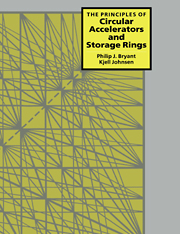Book contents
- Frontmatter
- Contents
- Foreword
- Coordinate system
- Symbols
- Useful Constants
- 1 Introduction
- 2 Basic concepts and constant-gradient focusing
- 3 Alternating-gradient focusing
- 4 Parameterisation of the transverse motion
- 5 Imperfections and resonances
- 6 Chromaticity
- 7 Longitudinal beam dynamics
- 8 Image and space-charge forces (transverse)
- 9 Coherent instabilities
- 10 Radiating particles
- 11 Diagnosis and compensation
- 12 Special aspects of circular colliders
- Appendix A Transverse particle motion in an accelerator
- Appendix B Accelerator magnets
- Appendix C Closed orbits
- Appendix D Phase equation
- Appendix E Vlasov equation
- References
- Index
3 - Alternating-gradient focusing
Published online by Cambridge University Press: 11 November 2009
- Frontmatter
- Contents
- Foreword
- Coordinate system
- Symbols
- Useful Constants
- 1 Introduction
- 2 Basic concepts and constant-gradient focusing
- 3 Alternating-gradient focusing
- 4 Parameterisation of the transverse motion
- 5 Imperfections and resonances
- 6 Chromaticity
- 7 Longitudinal beam dynamics
- 8 Image and space-charge forces (transverse)
- 9 Coherent instabilities
- 10 Radiating particles
- 11 Diagnosis and compensation
- 12 Special aspects of circular colliders
- Appendix A Transverse particle motion in an accelerator
- Appendix B Accelerator magnets
- Appendix C Closed orbits
- Appendix D Phase equation
- Appendix E Vlasov equation
- References
- Index
Summary
Machine designers now think almost exclusively in terms of alternating-gradient focusing, or strong focusing as it is also known. Their conversion from weak to strong focusing was rapid and decisive following the publication of Ref. 1 by Courant, Livingston and Snyder from the Brookhaven National Laboratory in 1952. CERN, for example, immediately abandoned its already-approved project for a 10 GeV/c weak-focusing synchrotron in favour of a 25 GeV/c strong-focusing machine, which it was estimated could be built for the same price. Strong focusing had broken through a cost–size–tolerance barrier. Both the betatron amplitude and the momentum compaction functions are compressed and the required aperture is typically reduced from tens of centimetres to centimetres. The momentum compaction is the more strongly affected, but in accelerators the momentum spread is usually small and the betatron amplitude reduction dominates. The stronger gradients alleviate the tolerance problem and the alternating structure leads naturally to a modular design for the lattice. It took several years, however, before this latter point was fully exploited for special optics modules.
Alternating-gradient focusing was an attractive idea, but it was not entirely new. It is based on a long-known result in classical optics and, in fact, an American-born engineer, Christofilos, living in Athens, had already filed a USA patent on the same scheme in 1950.
- Type
- Chapter
- Information
- Publisher: Cambridge University PressPrint publication year: 1993



